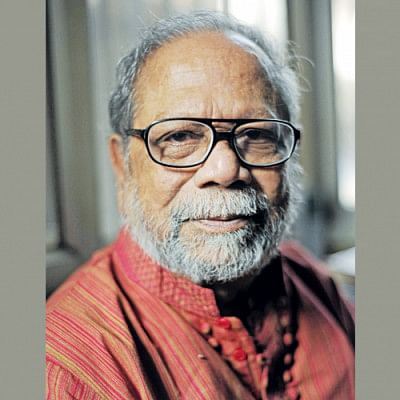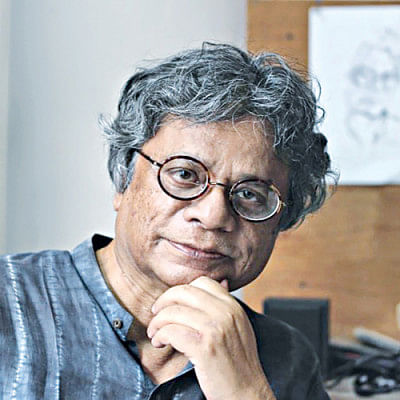“Murtaja Baseer’s passing is the end of an era” – Abul Monsur

Eminent artist Professor Abul Monsur, who was Murtaja Baseer's colleague at Chittagong University, evaluated the creative legacy of the pioneering art maestro in a recent conversation with The Daily Star.
"I met him in the 60s. He was a pretty established artist in the then West Pakistan, back then. As my father was friends with Shilpacharya Zainul Abedin, I met many artists at our residence," reminisced Abul Monsur. "I first saw him in 1968, while I was a student at the then Dacca Art College (now Faculty of Fine Art, University of Dhaka). When he came to his brother's residence in Elephant Road, I accompanied with several students, went to see his drawings. Later, when I joined Chittagong University in 1974, he became my colleague. I had a 25-year long friendship with him."
Apart from visual art, he wrote poems, short stories, novels and screenplays. He was an assistant director and art director of several films," said Abul Monsur, citing Murtaja Baseer as an exceptional artist and a versatile genius. "An important researcher and numismatist, he studied and interpreted coins of the Bengal Sultan period with the scholarly commitment of a historian. An avid autograph collector, he would always love archiving stamps and match boxes."

According to Monsur, Baseer was a dynamic personality, who would always remain absorbed in creative activities. Distinction was a trademark in his work. "He would regularly visit my residence. We had so many discussions on diverse issues, and opened my eyes on various aspects of art and made me learn about the painting styles, geometric forms and aesthetic values of early and pre-renaissance period artists like Giotto, Cimabue, Duccio, Simone Martini and Fra Angelico," mentioned Abul Monsur.
Abul Monsur, who regards Baseer as a socially conscious artist, evaluates his literary genius as a self-centred poet, who is credited with writing several masterpieces, as short stories. "As a teacher, he was really good. He could see the potential of a student and guide him/her in the right direction. He never tried to turn pupils into his followers. His creative perspectives and ever-changing mentality to adapt to new ideas was outstanding."
Initially, Baseer had a charm for abstraction, but later he returned to his roots and depicted paintings, taking inspiration from folk art. "He was a second-batch student of Dacca Art College. There came several talented artists like Aminul Islam, Mohammad Kibria, Rashid Choudhury, Kazi Abdul Baset, Abdur Razzaque, Qayyum Chowdhury, Devdas Chakraborty and Syed Jahangir. His passing is the end of an era," said Abul Monsur, who also talked about Murtaja Baseer creating mosaic artwork at Rajshahi University. The artwwork reflects our conventional heritage of terracotta and clay-burnt works. "This is an outstanding work by Baseer Bhai. Another of his finest works is installed in Bangladesh Bank. In my opinion he was a real master of drawings, comparable to Shilpacharya Zainul Abedin and Quamrul Hasan."
Recollecting his fond memories with the maestro, Abul Monsur said that he would regularly walk with him. "Flowers like Palash and Jarul have a signature mark in the cityscape of Chittagong. He would share his aesthetic tastes and thoughts on adorning city streets like circuit house with Palash and Jarul. The Language Movement veteran wanted people to pay tributes to the martyrs on 21st February walking along the street of Palash. He had the eyes of a true artist. He would meticulously observe nature and all so curiously and closely," concluded Abul Monsur.

 For all latest news, follow The Daily Star's Google News channel.
For all latest news, follow The Daily Star's Google News channel. 



Comments